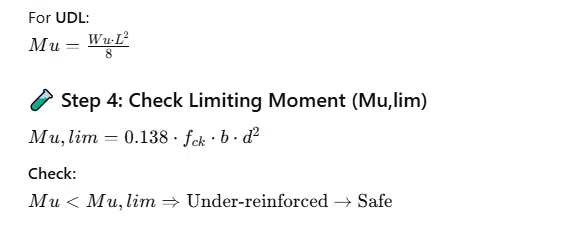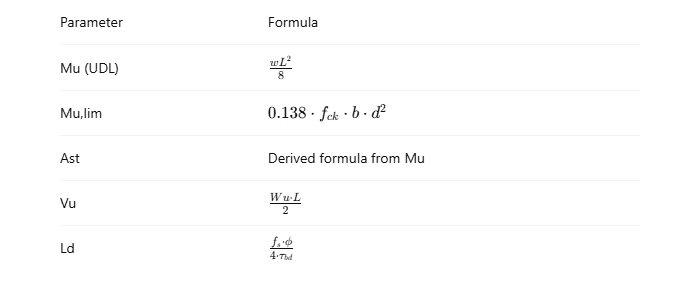🔰 Introduction
RCC (Reinforced Cement Concrete) beams are vital elements in the skeleton of any concrete structure. They resist loads applied laterally to their axis and are designed to handle bending moments, shear forces, and sometimes torsion.
In this blog, we break down the entire design process, cover all beam types, and explain Limit State Design (LSM)—as prescribed by IS 456:2000—with added insights and memory aids to help JKSSB Civil aspirants master this crucial topic.
🧱 Detailed Classification of RCC Beams
🔸 Based on Support Conditions
| Type | Description | Example Use |
|---|---|---|
| Simply Supported Beam | Resting freely on two supports; bending occurs between them | Small span beams, slab supports |
| Cantilever Beam | Fixed at one end, free at the other | Balconies, projections |
| Continuous Beam | More than two supports | Framed structures, bridges |
| Fixed Beam | Fixed at both ends, moments are resisted at ends | Industrial sheds |
| Overhanging Beam | Extension beyond the support(s) | Platform covers, overhangs |
🔸 Based on Geometry
| Type | Description | Diagram |
|---|---|---|
| Rectangular Beam | Most common; rectangular cross-section | 📏 |
| T-Beam | Monolithic slab and beam form ‘T’ shape | Used in slab-beam systems |
| L-Beam | Edge beam with slab on one side | Corners of slabs |
| I-Beam | Rare in RCC, more in steel | Not common in concrete |
🧠 RCC Design Philosophies (As per IS 456:2000)
1️⃣ Working Stress Method (WSM)
- Based on elastic theory
- Stresses kept within permissible limits
- Higher factor of safety used
- Now mostly obsolete in favor of LSM
Drawback:
Doesn’t represent actual failure modes or material behavior beyond elastic limit.
2️⃣ Ultimate Load Method (ULM)
- Uses factored loads and ultimate strengths
- Still doesn’t ensure serviceability (cracks/deflection)
3️⃣ ✅ Limit State Method (LSM) – Most Widely Used
LSM ensures:
🔹 Safety against collapse
🔹 Serviceability (no excessive deflection, cracking, vibration)
Two Types of Limit States:
- Limit State of Collapse (Strength, Stability)
- Limit State of Serviceability (Deflection, Cracking, Durability)
Why LSM is Better:
- More economical than WSM
- Reflects actual behavior of concrete and steel
- Used in all modern codes (IS 456, Eurocode, ACI)
📐 Detailed Design Procedure for RCC Beam (LSM)
🗒️ Step 1: Calculate Loads
- Dead Load (DL): Self-weight of beam, slab, finishes
DL=Volume×Unitweight(25kN/m3)DL = Volume \times Unit weight (25 kN/m^3) - Live Load (LL): From IS 875
- Factored Load (Wu):
Wu=1.5(DL+LL)Wu = 1.5(DL + LL) (IS 456:2000)
📏 Step 2: Assume Beam Dimensions
- Breadth bb = 230 mm (standard)
- Depth dd: span/depth ratios:
- Simply supported: L/d=20L/d = 20
- Cantilever: L/d=7L/d = 7
- Continuous: L/d=26L/d = 26
🔽 Step 3: Bending Moment (Mu)

🧪 Step 4: Check Limiting Moment (Mu,lim)

📊 Step 5: Area of Steel (Ast)

🥿 Step 6: Shear Design

🧰 Step 7: Min & Max Reinforcement

📊 Step 8: Deflection Check

📊 Step 9: Development Length

📓 Sample RCC Beam Design
Given:
- Span = 4 m, Load = 25 kN/m
- fck = 20 MPa, fy = 415 MPa
- b = 230 mm, d = 450 mm
Steps:
- Wu = 1.5 × 25 = 37.5 kN/m
- Mu = (37.5 × 4²)/8 = 75 kNm
- Check Mu < Mu,lim
- Calculate Ast
- Provide 2-20 mm + 2-16 mm bars
- 8 mm stirrups @ 200 mm c/c
⚙️ Practical Tips
- Always provide nominal stirrups
- Clear cover: 25 mm min
- Avoid over-reinforced sections
- Use hooks, bends for anchorage
- Use bar bending schedule for site accuracy
- Always check for ductility in seismic zones (refer IS 13920)
📚 Recommended IS Codes
- IS 456:2000 – RCC Design Code
- SP 16 – RCC Design Aids
- IS 875 – Loads
- IS 13920 – Earthquake Detailing
- IS 3370 – Liquid Retaining Structures (if applicable)
🪑 Formula Quick Recap

❓ FAQs on Design of RCC Beams (Civil Engineering)
1️⃣ What is the most commonly used design method for RCC beams in India?
✅ Limit State Method (LSM) as per IS 456:2000 is the most widely used method.
2️⃣ Why is LSM preferred over WSM and ULM?
LSM provides:
- A balance between safety and serviceability
- Economical design
- Better representation of actual failure behavior
3️⃣ What is the standard value of unit weight of RCC for load calculations?
✅ 25 kN/m³
4️⃣ What are under-reinforced and over-reinforced sections?
- Under-reinforced: Steel yields before concrete crushes → desirable & ductile
- Over-reinforced: Concrete fails before steel → brittle failure
5️⃣ How is shear reinforcement provided in RCC beams?
✅ Using vertical stirrups, calculated based on shear force VuV_uVu
6️⃣ What is development length (Ld)?
The minimum length of bar required to develop its full strength in concrete, given by:
Ld=fs⋅ϕ4⋅τbdL_d = \frac{f_s \cdot \phi}{4 \cdot \tau_{bd}}Ld=4⋅τbdfs⋅ϕ
7️⃣ What is the minimum percentage of steel in a beam as per IS 456?
✅ 0.85% of bd (for Fe 415 steel)
🧾 PYQs on RCC Beam Design (JKSSB / SSC JE / RRB)
Q1. Which method of RCC design considers both collapse and serviceability criteria?
a) Working Stress Method
b) Ultimate Load Method
✅ c) Limit State Method
d) Plastic Design Method
Q2. The factor used to convert working loads into design loads in LSM is:
a) 1.2
✅ b) 1.5
c) 2.0
d) 0.85
Q3. In LSM, the partial safety factor for concrete is:
✅ a) 1.5
b) 1.15
c) 0.87
d) 1.0
Q4. A rectangular beam of size 230×450 mm is subjected to a moment of 75 kNm. If fck = 20 MPa and fy = 415 MPa, the required area of steel is approximately:
a) 1250 mm²
b) 950 mm²
✅ c) 1075 mm²
d) 1400 mm²
Q5. As per IS 456:2000, the maximum area of tension reinforcement in a beam should not exceed:
a) 2% of cross-section
b) 6% of cross-section
✅ c) 4% of cross-section
d) 10% of cross-section
Q6. The clear cover to main reinforcement in beams should not be less than:
a) 20 mm
✅ b) 25 mm
c) 30 mm
d) 40 mm
Q7. The moment of resistance of a balanced RCC section depends on:
a) Only the area of steel
✅ b) Both concrete and steel strength
c) Span of beam
d) Bond between steel and concrete
✅ Conclusion: Mastering the Design of RCC Beams
The design of RCC (Reinforced Cement Concrete) beams is a cornerstone topic in structural engineering and an essential subject for JKSSB, SSC JE, and other civil engineering competitive exams. Understanding the fundamentals of beam behavior under various loads, the correct placement of reinforcement, and compliance with IS 456:2000 standards is crucial not just for exams but for practical field application as well.
Among the three design methods—Working Stress Method (WSM), Ultimate Load Method (ULM), and Limit State Method (LSM)—the LSM is the most adopted in modern engineering practice due to its balanced focus on both safety and serviceability. The classification of beams (singly reinforced, doubly reinforced, and flanged), the role of shear and torsional reinforcement, and the concept of under- and over-reinforced sections are key concepts that every civil engineering aspirant must thoroughly understand.
With increasing focus on sustainability and safety, mastering RCC beam design equips future engineers with the ability to create durable, economical, and safe structural elements. Consistent revision, problem-solving, and concept clarity in RCC design can help you secure crucial marks in JKSSB JE Civil exams and beyond.
📌 Pro Tip:
- Always refer to IS 456:2000 for code-compliant design.
- Practice numerical problems related to bending moment, shear force, and reinforcement area.
- Learn shortcuts and assumptions frequently used in objective exams.
📌 Join our Telegram Channel JKSSB CivilsCentral for regular updates, quizzes, PDF notes, and practice sets curated specifically for JKSSB aspirants.


